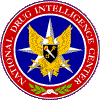ARCHIVED
![]() To Contents
Previous Page Next Page To Publication
Page To Home Pageage
To Contents
Previous Page Next Page To Publication
Page To Home Pageage
 |
National Drug Intelligence Center National Drug Threat Assessment 2004 April 2004 Scope and MethodologyThe National Drug Threat Assessment 2004 is a comprehensive assessment of the threat posed to the United States by the trafficking and abuse of illicit drugs. It was prepared through detailed analysis of the most recently available reporting from law enforcement, intelligence, and public health agencies. A critical component of this undertaking was information provided by more than 3,300 state and local law enforcement agencies through the National Drug Intelligence Center National Drug Threat Survey 2003. Details on the survey methodology and survey sample are provided in Appendix A. State and local law enforcement agencies also provided information through personal interviews with the National Drug Intelligence Center Field Program Specialists, a network of law enforcement professionals assembled by NDIC to promote information-sharing among federal, state, and local law enforcement agencies. This report addresses the trafficking and use of primary substances of abuse as well as the laundering of proceeds generated through illicit drug sales. Major substances of abuse are discussed in terms of their availability, demand, production and cultivation, transportation, and distribution. Primary market areas for each drug are identified and addressed in the report (see Figure 5). Primary market areas for cocaine, methamphetamine, heroin, and MDMA were determined through analysis of public health data and law enforcement reporting regarding use in these areas and the extent to which wholesale quantities are distributed from these areas to other markets. Primary market areas for marijuana were determined based on distribution alone because rates of marijuana use are relatively high and stable in markets throughout the country.
This report cites trademarked names such as OxyContin and Rohypnol in discussing the diversion and abuse of such substances. The use of any trademarked names in this assessment does not imply any criminal activity, criminal intent, or misdealing on the part of the companies that manufacture these drugs. All such citations are made for reference purposes only. National Drug Threat Survey data used in this report do not imply there is only one drug threat per state or region or that only one drug is available per state or region. A percentage given for a state or region represents the proportion of state and local law enforcement agencies in that state or region that identified a particular drug as their greatest threat or as available at low, moderate, or high levels. This assessment breaks the country into six regions as shown in Figures 1, 2, 3, and 4. Figure 1.
Six Regional Areas
Figure 2. Greatest Drug Threat - Percentage of State and Local Agencies Reporting
Percentages given represent the proportions of state and local law enforcement agencies nationwide that identified a particular drug as their greatest threat. Source: NDIC, National Drug Threat Survey 2003. Figure 3. Greatest Drug Threat by Region - Percentage of State and Local Agencies Reporting
Percentages given represent the proportions of state and local law enforcement agencies per region that identified a particular drug as their greatest drug threat. Source: NDIC, National Drug Threat Survey 2003.
Figure 4. Regional Drug Availability - Percentage of State and Local Agencies Reporting High Availability
Percentages given represent the proportions of state and local law enforcement agencies per region that identified a particular drug as available at high levels. Source: NDIC, National Drug Threat Survey 2003.
Figure 5. Primary Market Areas
Percentages areas for cocaine, methamphetamine, heroin, and MDMA were determined through analysis of public health data and law enforcement reporting regarding use in these areas and the extent to which wholesale quantities are distributed from these areas to other markets. Primary Market areas for marijuana were determined based on distribution alone. Source: NDIC, National Drug Threat Survey 2003.
End Note1. In this assessment wholesale distribution refers to the level at which drugs are purchased directly from a source of supply and sold, typically, to midlevel distributors in pound, kilogram, or multiunit quantities. Midlevel distribution refers to the level at which drugs are purchased directly from wholesalers in pound, kilogram, or multiunit quantities and sold in smaller quantities to other midlevel distributors or to retail distributors. Retail distribution refers to the level at which drugs are sold directly to users. |
End of page.